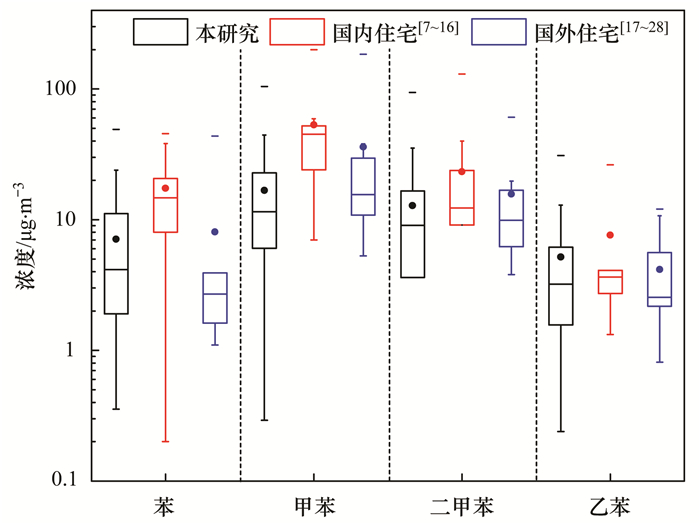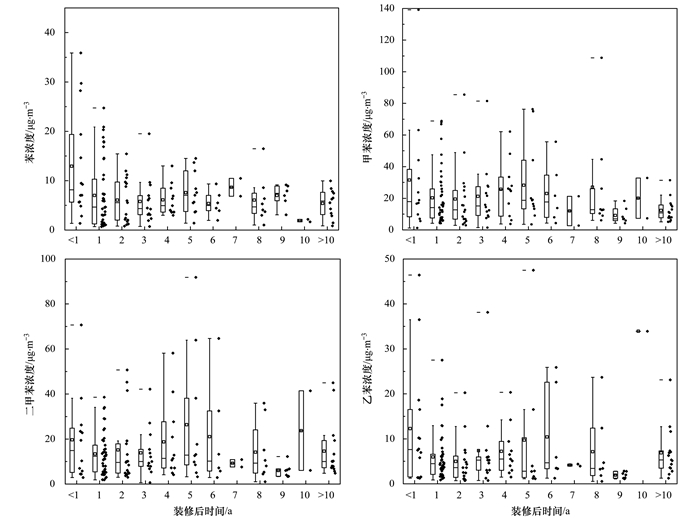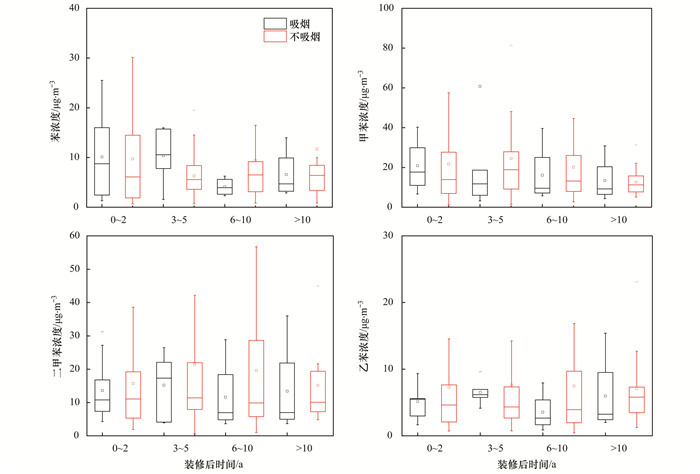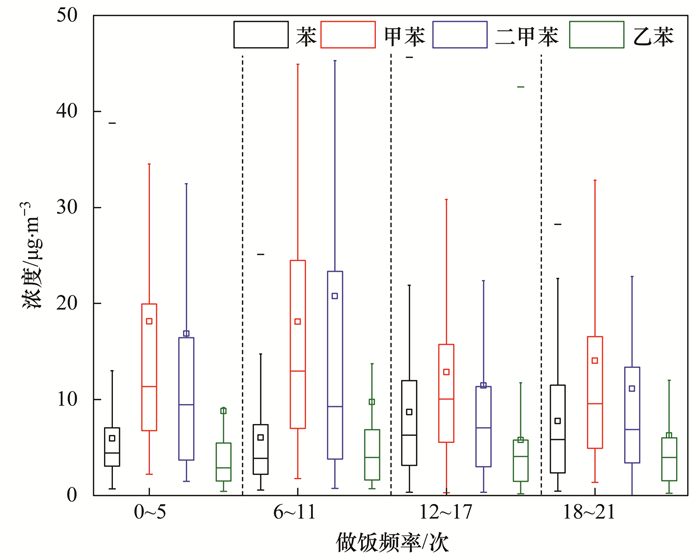世界卫生组织在2002年世界卫生报告中明确将室内空气污染、高血压、高胆固醇及肥胖症等共同列为人类健康的10大威胁, 室内空气污染被列为影响公众健康的世界最大危害之一[1].近年来, 随着我国经济的发展和人民生活水平的提高, 室内装饰装修已在生活中不可避免, 同时装修也带来了各种健康隐患, 室内装修和建筑材料释放的有害物质是造成室内空气甲醛和苯系物等污染的主要原因[2, 3].吸烟和厨房油烟产生的污染物也是中国住宅室内不可忽略的污染源, 其与室内污染物的关系有待研究.
以往对室内苯系物浓度的研究不在少数, 但往往仅关注某一个城市或地区, 且多针对新装修房子, 如甲苯的平均浓度[4, 5]从173.2~200.13 μg ·m-3; 杜正建等[4]的研究结果表明, 新装修包括新的装修材料、溶剂的使用和新家具是室内苯系物的主要来源.相比而言, 全国范围室内苯系物浓度的调查及苯系物与吸烟和做饭频率相关性的研究较少.本研究重点考察了室内苯系物的污染状况, 并提供了关于装修装饰后的住宅中苯系物暴露的统计数据以及相关标准的设定值讨论.
1 材料与方法 1.1 研究对象为了解中国住宅室内空气的污染状况, 2016年12月~2017年12月, 在全国5个气候区选取装修完工后1~20 a的住宅223所, 进行不同季节的多次入户室内空气采样, 采样点包括客厅、卧室及厨房.住宅的地理位置、数量及各地区1 a室内的平均温度和平均相对湿度见表 1.室内温度、湿度数据采用Ikair在线长期监测和统计得到.
|
|
表 1 各地区一年室内平均温度和平均相对湿度1) Table 1 Average annual temperature and relative humidity in each region |
1.2 问卷调查
采用自制问卷调查的方法, 对住宅装修情况、居住习惯等进行调查.问卷内容包括房子的建成年代、装修完工时间、内部主要功能房间(客厅、卧室、厨房)的主要装修材料以及家具材质; 居住习惯包括做饭习惯(做饭频率、做菜方式和种类、使用燃料等)和吸烟习惯(吸烟量、吸烟的位置等).其中表 2给出了详细的住宅基本特征信息.
|
|
表 2 各地区住宅的基本特征/% Table 2 Basic characteristics of houses surveyed in each region/% |
1.3 采样和分析方法
空气中可挥发性有机物的采样按照国标进行[6], 采样前关闭门窗等通风设施12 h, 记录采样时温度、湿度和气压.采用Tenax-TA管和空气采样泵(北京劳动保护研究所)对室内空气主动采样20 min, 流量为0.5L ·min-1.取样完成后, 用铝箔密封Tenax-TA管并立即送回实验室进行分析.在整个取样期间, 门窗均关闭.
采用气相色谱质谱(GC/MS)法对BTEX(苯、甲苯、二甲苯和乙苯)浓度进行了分析.先采用二次液氮冷阱热解吸器(TD, Markes TD-100, Ltd.)对样品解吸, 然后用带有质谱仪(MS, Inc. Agilent 7890B)的气相色谱仪(GC, Ltd. PERSEE M7-80EI)进行分析.色谱柱类型为DB-INNOWAX[60 m×0.25 mm(i. d.)×0.25 μm], 且采用无分流进样.离子源和界面温度分别为230℃和200℃. GC的初始温度保持在50℃持续2 min, 然后以9℃ ·min-1的速率升高至130℃, 持续1 min, 再以10℃ ·min-1的速率提高到240℃, 最后保持10 min(共33 min).以氦作为载体气体, 流量为1.2mL ·min-1.质谱仪在选定的离子监测(SIM)模式和扫描模式(质量范围为35~400 u)下运行.
1.4 质量保证每月采用外部标准方法对BTEX浓度进行质量保证.分别采用0.02、0.05、0.08、0.1、0.2、0.5、0.8和1.0 μg的甲苯标准值到得到一条校准曲线, 其R2高于99%.为了防止运输过程中对空气样品造成的污染, 在每次试验中, 都取一根空白样品管进行分析, 现场空白样品的采集和空气样品的采集是同时进行的.此外, 还定期对BTEX回收率进行抽样检查.在统计分析中, 低于测量检测限(MDLs)或未被检测到的BTEX水平与半数的测量检测限一起被分离.
1.5 数据分析采用独立样本t检验对室内的苯系物浓度与有无长期吸烟习惯行为的均值差异在统计学上的显著性进行检验; 对装修完工时间、做饭频率与室内苯系物浓度的相关性采用了Spearman相关分析方法.一般来说, P < 0.05显示差异有统计学意义.所有的统计分析均采用软件SPSS 24.0实现.
2 结果与分析 2.1 苯系物浓度水平表 3给出了全国223户住宅室内的苯系物浓度值.苯、甲苯、二甲苯和乙苯的算术平均浓度分别为6.78、17.4、17.68和9.87 μg ·m-3.可以看到, 住宅室内苯系物浓度分布范围较大, 在0~300 μg ·m-3范围内都有分布, 因为本次研究没有特意关注新装修住宅, 房子装修时间在1~20 a分布, 这更能反映中国住宅内的普遍状况.
|
|
表 3 全国223户住宅室内苯系物浓度/μg·m-3 Table 3 Concentration value of the benzene series in 223 houses in China/μg ·m-3 |
图 1为本研究和以往针对室内苯系物浓度的研究结果[7~28], 其中数据均为新装修(装修后时间≤4a)的住宅室内浓度.从中可以看出, 除乙苯外, 以往对国内住宅室内BTX浓度的研究结果均高于本研究和对国外住宅室内浓度的研究结果, 而本次测试的BTEX浓度水平与国外室内的苯系物浓度水平相一致.产生这种差异的可能原因是:以往对国内和国外住宅苯系物浓度的调查年份主要集中在1999~2010年, 在1990~2010年间, 中国的城市化面积、复合木地板和城市空调设备的销售量等均呈现指数上升趋势[29], 显著改变了住宅室内污染物的浓度[30], 而本次调查时间为2016~2017年, 人员安全意识的提高促进了环保材料和室内净化产品的使用, 可能使得苯系物浓度低于以往的国内住宅室内浓度; 而国外对于室内苯系物浓度的标准限值低于国内[31].

|
图 1 国内外室内苯系物平均浓度水平比较 Fig. 1 Comparison of average concentration of the benzene series in China and abroad |
室内苯系物污染的来源不仅包括室内材料及人员活动, 也包括室外空气.一些发达国家如英国、加拿大和德国等, 室内苯、甲苯和二甲苯的含量与室外的浓度基本一致, 室外苯系物主要来源于汽车尾气排放和工业燃料的燃烧[32, 33]; 在中国, 有相关研究表明我国一般住宅室外苯、甲苯、二甲苯和乙苯浓度范围分别为:4~7、9~11、3~4和6~7 μg ·m-3[34, 35], 这与本研究的室内苯系物浓度水平一致.但交通主干道大气中的苯、甲苯和二甲苯浓度范围分别为:15~25、60~65和20~100 μg ·m-3, 且研究表明观测区域的苯和甲苯主要来源于机动车尾气排放[36, 37], 表明经过长时间以后, 室内苯系物浓度可能同时受到室内源和室外源的影响.
2.2 室内苯系物浓度与温湿度的相关性各地区不同温湿度下室内苯系物平均浓度见图 2和图 3, 温湿度均为采样时的室内实测数据.从图 2可以看出, 各个地区的室内BTEX浓度主要分布在3~300 μg ·m-3之间, 温度的升高并没有使室内苯系物浓度明显增加; 同样, 从图 3可以看出, 室内BTEX浓度与湿度也没有直接的相关性.丁桂艳等[38]的结果表明:房间内挥发性有机污染物经过2个月左右的散发后, 浓度会有大幅度地降低, 房间内剩余的污染物浓度比较小.因此, 可能室内苯系物散发1 a或者2 a后, 室内剩余的苯系物浓度已经足够低, 导致温湿度对其影响不大.相比之下, 笔者之前对于室内甲醛浓度的研究[39]结果表明, 随着温度的升高, 室内甲醛的浓度也明显升高, 但苯系物并没有类似的规律.

|
图 2 各地区室内BTEX浓度随温度的变化 Fig. 2 Variation in indoor BTEX concentration with temperature in different regions |

|
图 3 各地区室内BTEX浓度随湿度的变化 Fig. 3 Variation in indoor BTEX concentration with relative humidity in different regions |
图 4给出了不吸烟家庭的室内苯、甲苯、二甲苯和乙苯浓度随装修后时间的变化趋势, 其中苯(R=-0.517, P=0.08)、甲苯(R=-0.483, P=0.112)、二甲苯(R=-0.063, P=0.846)和乙苯(R=-0.112, P=0.729)浓度均与装修后时间成负相关关系, 但从统计学意义上看无显著性差异.从图中也可以看到, 装修后2 a内, 室内苯系物浓度有明显的下降; 装修后2 a以上, 苯系物浓度与装修后的时间关系不大, 但有个别样本超高现象, 这说明可能有其他特殊的污染源.刘晓途等[40]的研究发现:住宅室内的主要空气污染物为甲醛、甲苯和二甲苯等装修型污染物; 新装修住宅室内各种污染物均呈现较高的浓度水平; 除甲醛外, 其他挥发性有机物随着竣工时间的推移而快速下降, 这与本研究中装修后2 a内的室内苯系物浓度明显下降结果一致.

|
图 4 不吸烟家庭室内BTEX浓度随装修后时间的变化 Fig. 4 Variation in indoor BTEX concentration in non-smoking houses with time after decoration |
众所周知, 苯、甲苯、二甲苯和乙苯与吸烟环境有关. 图 5显示了吸烟家庭和不吸烟家庭的室内苯系物浓度, 可以看到, 装修后2 a内, 吸烟家庭的苯和甲苯平均浓度高于不吸烟家庭, 而吸烟家庭的二甲苯和乙苯没有高于不吸烟家庭的, 在装修后0~2 a内, 室内苯系物浓度在吸烟与不吸烟家庭中的显著性分别为P=0.906(苯)、P=0.906(甲苯)、P=0.732(二甲苯)和P=0.514(乙苯); 装修后2 a以上的室内苯系物浓度与是否吸烟没有直接的相关性.因为本次研究在采样期间, 室内并没有吸烟活动, 但人员之前在房间内有长期吸烟行为, 这可能说明了三手烟[41]的长期影响. Charles等[42]的研究结果表明:香烟的烟气中苯和甲苯的散发量最多; 虽然吸烟时甲苯的散发量高于苯, 但是甲苯的挥发速度高于苯, 而苯更易于以三手烟的形式吸附在室内, 这可能导致长期室内苯的贡献率大于甲苯.

|
图 5 不同装修程度吸烟和不吸烟家庭的室内苯系物浓度水平 Fig. 5 Variation in indoor BTEX concentration with time after decoration |
对于中国家庭, 在家里做饭是很常见的行为, 而厨房油烟是室内污染气体的来源之一, 对居住者的身体健康有着较大的影响, 本次研究也对厨房油烟与房间内苯系物浓度之间的相关性进行了分析.苯(P=0.06)、甲苯(P=0.12)、二甲苯(P=0.085)和乙苯(P=0.276)浓度与做饭频率之间均无显著性差异, 不同的做饭频率对应的苯、甲苯、二甲苯和乙苯的浓度见图 6.可以看出, 做饭频率与室内苯系物浓度之间没有明显的关系变化. Wang等[43]对厨房做饭时散发的VOC种类进行了研究, 结果表明:烷类是主要的VOC污染物, 51.26%±23.87%的烷类和24.33%±11.69%的O-VOCs在做饭散发的VOC中占主导地位; 煎炸食物产生的醛类也占一定的主导地位.这表明做饭产生的主要是烷烃类和醛酮类, 房间中苯系物浓度与做饭频率相关性不大.

|
图 6 室内BTEX浓度随做饭频率的变化 Fig. 6 Variation in indoor BTEX concentration with cooking frequency |
国内外有关卫生组织、协会对室内苯系物浓度的限值见表 4. 《室内空气质量》(GB/T 18883-2002)对室内苯、甲苯和二甲苯的限值分别是110、200和200μg ·m-3.但国内标准是短期(1 h)限值, 尚没有室内24 h或长期暴露的BTEX参考浓度, 1 h限值对急性效应有一定的保护作用, 但长期暴露可能有更高的健康风险.本研究的结果表明:在223个家庭中, 仅有1户甲苯浓度和2户二甲苯浓度超过《室内空气质量》标准限值.与国内不同, 其他国家或组织的标准是长期暴露限值, 而且要远低于中国标准, 如世界卫生组织(WHO)没有对室内苯浓度规定限值, 认为空气中只要存在苯, 就会对人体健康产生影响.依据文献[6], 对于苯、甲苯和二甲苯有95%~98%的样本达标, 但其实有62%的样本苯浓度已超过OEHHA长期暴露标准值3μg·m-3.文献[6]中也指出要保证暴露情况下的健康影响, 也应当考虑苯系物长期暴露的危害.
|
|
表 4 国内外有关室内苯系物标准1) Table 4 Indoor standards for the benzene series at home and abroad |
4 结论
(1) 全国室内苯、甲苯、二甲苯和乙苯的平均浓度分别为:6.78、17.4、17.68和9.87μg ·m-3, 其中有95%~98%的BTX浓度低于国内标准1 h均值.
(2) 中国对室内苯系物浓度的标准是短期(1 h)限值, 而其他国家或组织的标准限值是长期暴露限值且远低于中国标准.
(3) 装修完工时间、吸烟和做饭频率与室内苯系物浓度的相关性:①室内苯系物浓度仅在装修后2 a内有明显的降低; 与装修完工时间呈不显著的负相关关系.可能由于室内苯系物散发1 a或2 a后, 室内剩余的苯系物浓度已经足够低, 装修时间的长短对其已经没有太大影响. ②装修程度一致时, 吸烟和不吸烟家庭中室内苯系物浓度无显著性差异, 但吸烟时散发的苯可能更易于以三手烟的形式存在于室内, 长期室内苯的贡献率大于甲苯. ③做饭时产生的挥发性有机物主要是烷烃和醛酮类, 而房间中苯系物浓度与做饭频率的相关性不大.
| [1] | 白志鹏, 韩旸, 袭著革. 室内空气污染与防治[M]. 北京: 化学工业出版社, 2006: 1-2. |
| [2] | 张胜军, 姚晓青, 蒋欣. 室内装修后苯、甲苯、二甲苯和甲醛污染调查[J]. 中国环境监测, 2004, 20(4): 23-24. DOI:10.3969/j.issn.1002-6002.2004.04.008 |
| [3] | Zhang J F, Smith K R. Indoor air pollution:a global health concern[J]. British Medical Bulletin, 2003, 68(1): 209-225. DOI:10.1093/bmb/ldg029 |
| [4] | Du Z J, Mo J H, Zhang Y P, et al. Benzene, toluene and xylenes in newly renovated homes and associated health risk in Guangzhou, China[J]. Building and Environment, 2014, 72: 75-81. DOI:10.1016/j.buildenv.2013.10.013 |
| [5] | Dai H X, Jing S G, Wang H L, et al. VOC characteristics and inhalation health risks in newly renovated residences in Shanghai, China[J]. Science of the Total Environment, 2017, 577: 73-83. DOI:10.1016/j.scitotenv.2016.10.071 |
| [6] | GB/T 18883-2002, 室内空气质量标准[S]. |
| [7] | Guo H. Source apportionment of volatile organic compounds in Hong Kong homes[J]. Building and Environment, 2011, 46(11): 2280-2286. DOI:10.1016/j.buildenv.2011.05.008 |
| [8] | Zhou J A, You Y, Bai Z P, et al. Health risk assessment of personal inhalation exposure to volatile organic compounds in Tianjin, China[J]. Science of the Total Environment, 2011, 409(3): 452-459. DOI:10.1016/j.scitotenv.2010.10.022 |
| [9] | Lee S C, Li W M, Ao C H. Investigation of indoor air quality at residential homes in Hong Kong-case study[J]. Atmospheric Environment, 2002, 36(2): 225-237. DOI:10.1016/S1352-2310(01)00435-6 |
| [10] | Liu Q Y, Liu Y J, Zhang M G. Personal exposure and source characteristics of carbonyl compounds and BTEXs within homes in Beijing, China[J]. Building and Environment, 2013, 61: 210-216. |
| [11] | Liang W H, Yang C Q, Yang X D. Long-term concentrations of volatile organic compounds in a new apartment in Beijing, China[J]. Building and Environment, 2014, 82: 693-701. DOI:10.1016/j.buildenv.2014.10.016 |
| [12] |
韩文霞. 2008年安阳市装修居室室内空气污染与入住居民不良反应发生情况调查[J]. 预防医学论坛, 2011, 17(5): 411-413. Han W X. Investigation on indoor air pollution and dwellers' adverse reaction in Anyang City, 2008[J]. Preventive Medicine Tribune, 2011, 17(5): 411-413. |
| [13] |
方建龙, 杨旭, 李红, 等. 北京与武汉部分儿童家庭室内空气中甲醛及挥发性有机物调查[J]. 环境与健康杂志, 2014, 31(7): 585-586. Fang J L, Yang X, Li H, et al. Survey of formaldehyde and TVOC in indoor air in families with children in Beijing and Wuhan[J]. Journal of Environment and Health, 2014, 31(7): 585-586. |
| [14] | Guo H, Lee S C, Li W M, et al. Source characterization of BTEX in indoor microenvironments in Hong Kong[J]. Atmospheric Environment, 2003, 37(1): 73-82. DOI:10.1016/S1352-2310(02)00724-0 |
| [15] | Pu Z N, Huang L H, Yue Y, et al. Characteristics of carbonyls in Beijing urban residences:concentrations, source strengths and influential factors[J]. Procedia Engineering, 2015, 121: 2052-2059. DOI:10.1016/j.proeng.2015.09.206 |
| [16] | Hu R Y, Liu G J, Zhang H, et al. Levels, characteristics and health risk assessment of VOCs in different functional zones of Hefei[J]. Ecotoxicology and Environmental Safety, 2018, 160: 301-307. DOI:10.1016/j.ecoenv.2018.05.056 |
| [17] | Son B, Breysse P, Yang W. Volatile organic compounds concentrations in residential indoor and outdoor and its personal exposure in Korea[J]. Environment International, 2003, 29(1): 79-85. DOI:10.1016/S0160-4120(02)00148-4 |
| [18] | Masih A, Lall A S, Taneja A, et al. Exposure profiles, seasonal variation and health risk assessment of BTEX in indoor air of homes at different microenvironments of a terai province of northern India[J]. Chemosphere, 2017, 176: 8-17. DOI:10.1016/j.chemosphere.2017.02.105 |
| [19] | Su F C, Mukherjee B, Batterman S. Determinants of personal, indoor and outdoor VOC concentrations:an analysis of the RIOPA data[J]. Environmental Research, 2013, 126: 192-203. DOI:10.1016/j.envres.2013.08.005 |
| [20] | Azuma K, Uchiyama I, Uchiyama S, et al. Assessment of inhalation exposure to indoor air pollutants:screening for health risks of multiple pollutants in Japanese dwellings[J]. Environmental Research, 2016, 145: 39-49. DOI:10.1016/j.envres.2015.11.015 |
| [21] | Hinwood A L, Rodriguez C, Runnion T, et al. Risk factors for increased BTEX exposure in four Australian cities[J]. Chemosphere, 2007, 66(3): 533-541. DOI:10.1016/j.chemosphere.2006.05.040 |
| [22] | Shin S H, Jo W K. Volatile organic compound concentrations, emission rates, and source apportionment in newly-built apartments at pre-occupancy stage[J]. Chemosphere, 2012, 89(5): 569-578. DOI:10.1016/j.chemosphere.2012.05.054 |
| [23] | Esplugues A, Ballester F, Estarlich M, et al. Indoor and outdoor air concentrations of BTEX and determinants in a cohort of one-year old children in Valencia, Spain[J]. Science of the Total Environment, 2010, 409(1): 63-69. DOI:10.1016/j.scitotenv.2010.09.039 |
| [24] | Bari A, Kindzierski W B, Wheeler A J, et al. Source apportionment of indoor and outdoor volatile organic compounds at homes in Edmonton, Canada[J]. Building and Environment, 2015, 90: 114-124. |
| [25] | Schlink U, Rehwagen M, Damm M, et al. Seasonal cycle of indoor-VOCs:comparison of apartments and cities[J]. Atmospheric Environment, 2004, 38(8): 1181-1190. DOI:10.1016/j.atmosenv.2003.11.003 |
| [26] | Jia C R, Batterman S, Godwin C. VOCs in industrial, urban and suburban neighborhoods, Part 1:indoor and outdoor concentrations, variation, and risk drivers[J]. Atmospheric Environment, 2008, 42(9): 2083-2100. DOI:10.1016/j.atmosenv.2007.11.055 |
| [27] | Xu J, Szyszkowicz M, Jovic B, et al. Estimation of indoor and outdoor ratios of selected volatile organic compounds in Canada[J]. Atmospheric Environment, 2016, 141: 523-531. DOI:10.1016/j.atmosenv.2016.07.031 |
| [28] | Hazrati S, Rostami R, Farjaminezhad M, et al. Preliminary assessment of BTEX concentrations in indoor air of residential buildings and atmospheric ambient air in Ardabil, Iran[J]. Atmospheric Environment, 2016, 132: 91-97. DOI:10.1016/j.atmosenv.2016.02.042 |
| [29] | Zhang Y P, Mo J H, Weschler C J. Reducing health risks from indoor exposures in rapidly developing urban China[J]. Environmental Health Perspectives, 2013, 121(7): 751-755. DOI:10.1289/ehp.1205983 |
| [30] | Weschler C J. Changes in indoor pollutants since the 1950s[J]. Atmospheric Environment, 2009, 43(1): 153-169. DOI:10.1016/j.atmosenv.2008.09.044 |
| [31] | ANSI/ASHRAE 62.1-2013, Ventilation for acceptable indoor air quality (includes ANSI/ASHRAE addenda listed in appendix J)[S]. |
| [32] | Caselli M, de Gennaro G, Marzocca A, et al. Assessment of the impact of the vehicular traffic on BTEX concentration in ring roads in urban areas of Bari (Italy)[J]. Chemosphere, 2010, 81(3): 306-311. DOI:10.1016/j.chemosphere.2010.07.033 |
| [33] | Sax S N, Bennett D H, Chillrud S N, et al. A cancer risk assessment of inner-city teenagers living in New York City and Los Angeles[J]. Environmental Health Perspectives, 2006, 114(10): 1558-1566. DOI:10.1289/ehp.8507 |
| [34] | Ohura T, Amagai T, Shen X Y, et al. Comparative study on indoor air quality in Japan and China:characteristics of residential indoor and outdoor VOCs[J]. Atmospheric Environment, 2009, 43(40): 6352-6359. DOI:10.1016/j.atmosenv.2009.09.022 |
| [35] | Zhang Y J, Mu Y J, Liu J F, et al. Levels, sources and health risks of carbonyls and BTEX in the ambient air of Beijing, China[J]. Journal of Environmental Sciences, 2012, 24(1): 124-130. DOI:10.1016/S1001-0742(11)60735-3 |
| [36] |
孟凡昊, 秦敏, 梁帅西, 等. 合肥市典型交通干道大气苯系物的特征分析[J]. 环境科学, 2018, 39(9): 4060-4069. Meng F H, Qin M, Liang S X, et al. Characteristics of atmospheric BTX near a main road in Hefei City[J]. Environmental Science, 2018, 39(9): 4060-4069. |
| [37] |
叶丛雷, 谢品华, 秦敏, 等. 广州市交通主干道空气中苯系物的测量[J]. 环境科学, 2012, 33(11): 3718-3724. Ye C L, Xie P H, Qin M, et al. BTX monitoring nearby main road traffic in Guangzhou[J]. Environmental Science, 2012, 33(11): 3718-3724. |
| [38] | 丁桂艳.室内装饰材料污染物散发过程的研究[D].保定: 华北电力大学(河北), 2009. http://cdmd.cnki.com.cn/Article/CDMD-10079-2009169359.htm |
| [39] | Dai X L, Liu J J, Yin Y H, et al. Modeling and controlling indoor formaldehyde concentrations in apartments:on-site investigation in all climate zones of China[J]. Building and Environment, 2018, 127: 98-106. DOI:10.1016/j.buildenv.2017.10.036 |
| [40] |
刘晓途, 闫美霖, 段恒轶, 等. 我国城市住宅室内空气挥发性有机物污染特征[J]. 环境科学研究, 2012, 25(10): 1077-1084. Liu X T, Yan M L, Duan H Y, et al. Characteristics of indoor volatile organic compounds in urban residential microenvironments in China[J]. Research of Environmental Sciences, 2012, 25(10): 1077-1084. |
| [41] | 人民网(日本频道).日本地方政府新规吸烟后45分钟内不准进电梯[EB/OL]. http://japan.people.com.cn/n1/2018/0330/c35421-29899471.html, 2018-03-30. |
| [42] | Charles S M, Batterman S A, Jia C R. Composition and emissions of VOCs in main-and side-stream smoke of research cigarettes[J]. Atmospheric Environment, 2007, 41(26): 5371-5384. DOI:10.1016/j.atmosenv.2007.02.020 |
| [43] | Wang H L, Xiang Z Y, Wang L N, et al. Emissions of volatile organic compounds (VOCs) from cooking and their speciation:a case study for Shanghai with implications for China[J]. Science of the Total Environment, 2018, 621: 1300-1309. DOI:10.1016/j.scitotenv.2017.10.098 |
 2019, Vol. 40
2019, Vol. 40


